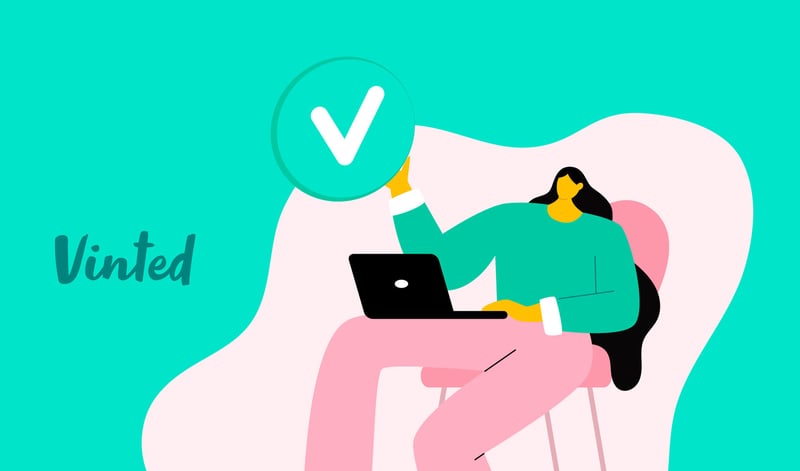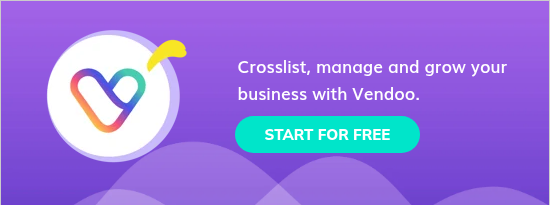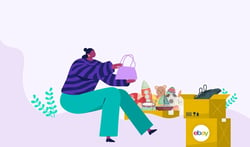If you’ve ever wondered “is Vinted legit?”, you’re not alone. The second-hand selling app has grown into one of the most talked-about marketplaces for buying and selling pre-owned items online. Vinted launched in 2008 and has since expanded to serve millions of users across Europe and North America, offering a platform that lets individuals list apparel, accessories, and other goods directly to buyers without charging seller fees.
What is Vinted?
Vinted is based in Lithuania with offices in Amsterdam, Berlin, Hamburg, and Prague. They became the first unicorn in Lithuania as a privately held startup valued over $1 billion. Vinted's expansive marketplace serves a staggering 80+ million users located throughout 19 countries spanning Europe and North America. A rapidly expanding European company, Vinted, has recently launched its own shipping logistics service, VintedGo. Their primary goal is to improve the delivery process and make it more convenient for their users.
While Vinted has made a name for itself in the European market, its expansion to the United States in 2013 has been met with mixed results. Despite its user-friendly interface and focus on sustainable fashion, Vinted has struggled to compete in a crowded reselling market dominated by the likes of eBay, Poshmark, and Mercari.
Pros and Cons of Selling on The Vinted App
Much like any resale platform, Vinted carries with it a set of benefits and drawbacks for sellers. It's important to clarify that the insights I'm about to share aren't drawn from my personal experiences. Instead, they are gathered from an extensive search on YouTube and various online forums where users share their experiences and thoughts about selling on Vinted. This exploration has provided a broad spectrum of perspectives that can help us understand what it's like to use Vinted as a seller.
Pro: No Seller Fees
One of the cool things about Vinted is that they don't make the seller pay any fees! On Vinted, it's the buyer who forks out a fixed fee of 70 cents per transaction and also a variable fee that's 5% of the total order value. They call this the Buyer Protection Fee. The deal is in exchange for this fee, Vinted will cover the cost if any items get lost or damaged.
Vinted is a better option for sellers compared to other marketplaces like Poshmark or Mercari. This is because these marketplaces charge sellers a fee ranging from 10-25%, whereas Vinted does not. Therefore, Vinted is a great option for sellers.
Con: No Resellers Allowed
So, you know how Vinted doesn't charge sellers any fees, right? Well, there's a little catch to that "too good to be true" deal... They don't allow resellers or commercial sellers on their platform. I know, bummer! If they get a whiff that you're running a business or selling items in bulk, they'll be quick to suspend or even block your account. Now, is there a workaround to this? I'm sure there is, but this is something to consider if you want to add Vinted as your reselling platform.
Pro: User Friendly
Both the app and website versions are easy to navigate and list an item. On Vinted, you can upload 20 photos and enter titles and descriptions that can be longer than 80 characters. Based on the information you provide, such as the title and photos, Vinted will suggest the appropriate category, brand, size, and color for your item.

Pro: You can crosslist to Vinted using Vendoo
If you're a seasoned seller looking to expand to a new marketplace, Vinted is an excellent choice. However, crosslisting can be time-consuming—this is where tools like Vendoo come in handy. Vendoo integrates with over 11 marketplaces in the U.S., allowing you to efficiently delist and relist items in bulk to refresh stale listings and attract new buyers.
Additionally, Vendoo’s Sale Detection feature takes the stress out of managing multiple platforms. Once an item sells on Vinted, Vendoo automatically removes it from the remaining marketplaces—such as Poshmark, eBay, Mercari, Depop, and Whatnot—helping you avoid accidental double sales.
Ready to start crosslisting? Sign up for Vendoo for FREE today!
Con: Manual Delist & Relist Process
As seasoned sellers, we all know the power of delisting and relisting a stale item so it can appear on the top of the search feed. Vinted offers a "bump" feature where you pay for an individual item to get more visibility within 3 or 7 consecutive days. You pay the fee upfront and it is non-refundable if your item sells or not. On the Vinted website, it does not tell you how they are calculating this fee (geez, talk about transparency!) but after doing my own testing, these are the results:

As you can see, I didn't get far while doing my research because I got blocked on the app! Stay tuned for an upcoming Youtube video about this!
Pro: Buyer Pays for Shipping
As shipping costs became more of a nuisance, having another selling platform that forces buyers to pay for shipping is refreshing (for sellers). Vinted offers only three types of shipping options:

Small: $6.92
Max 1 lbs, 22" x 18" x 15"
USPS Ground Advantage (First Class) with $100 Insurance
Medium: $12.52
Max 2 lbs, length + girth <108"
USPS Priority with $100 Insurance
Large: $15.46
Max. 4 lbs, length + girth < 108"
USPS Priority with $100 Insurance
Unfortunately, Vinted's only shipping option is through USPS.
Con: Limited Shipping Options
While it's awesome that Vinted doesn't make sellers foot the bill for shipping, there's a flip side to that coin – the shipping costs are sky-high! I mean, it's almost like you're paying for a first-class ticket on a transatlantic flight for your items. And the kicker? Sellers don't even have the option to offer a more budget-friendly shipping alternative. It's like being stuck between a rock and a hard place. You're glad you're not the one shelling out for shipping, but at the same time, you can't help but wince at the steep prices your buyers have to pay. It definitely adds another layer of complexity to the whole selling process.
Fun fact: Did you know sellers in Europe have to pay the shipping upfront and get reimbursed once the buyer receives their item?

Con: The Buyer's Experience is Lacking (and the Seller's too!)
Okay, you're probably thinking, what's that got to do with me as a seller? Well, put yourself in their shoes. Would you go back if you had a terrible experience shopping at a store? This is broken down into different sections, so let's start with...
Bundling is a hassle: As a seller, you can offer tiered discounts to encourage buyers to buy more items from your store. Buyers can add items to their bundle and get a discounted price. However, remember that adding items to the bundle does not automatically complete the purchase. The buyer has to send a request to the seller, for they need to input the package size (small, medium or large) and approve the transaction. After that, the buyer can immediately click the 'buy now' button.
Why this is an inconvenience…
Buyer: One of the perks of shopping online is the convenience of buying products within minutes. If I want to negotiate or bargain with a seller, I can make use of the 'make an offer' button. But if there are multiple hot items that I want to snag quickly, it would be safer for me to buy them individually and pay shipping multiple times. There are countless Reddit threads of buyers complaining that sellers are ignoring their bundle requests or it took days for the transaction to happen.
Seller: We are not glued to our phones 24/7, or at least I am, and being able to respond quickly to an interested buyer is crucial. Even if you did your part and responded quickly, the buyer still has to finalize the transaction aka click 'buy now'. The disadvantage is that the bundles are non-binding, and the buyer has no fixed deadline to buy the items.
Another thing to consider, the buyer also has the option to make an offer on the bundle even after you approve the transaction. Not only this drags out the entire purchasing process, but this opens up doors to lowball offers.
Make an Offer option is not great: If you are unhappy with eBay's lack of an autopayment option or Poshmark's lowballers, you will likely be frustrated with Vinted's 'make offer' feature.
Why this is an inconvenience…
Buyer: You can only throw your hat in the ring a maximum of 5 times per day. And then, once you've made your move, it's a waiting game. The seller has up to 72 hours to respond to your offer. That's three whole days of wondering if the seller is going to accept your offer or not.
Seller: You, as the seller, also have a limit of 5 offers per day, just like the buyer. Bad news for you, the buyer can send a 40% offer (yikes!) unless your item is priced at $1. More bad news, when you accept the offer, the item is automatically marked as "sold" even though the buyer has not purchased it. The buyer has up to 24 hours to buy it.
If you make a counteroffer, the buyer has up to 72 hours to respond and purchase the item.
The return/refund process is not buyer-friendly: Okay, this may sound like great news for you as a seller, but this can also open up doors to scammers and negative feedback. Again, if there are fewer buyers in the platform (due to bad user experience), then selling your items in Vinted is going to be a struggle.
Why this is an inconvenience…
Buyer: When you purchase an item (or bundle) from Vinted, you are required to pay their Buyer Protection which is a fixed amount of $.70 plus 5% of the item's price (excluding taxes and shipping cost). However, Buyer Protection comes with limitations such as:
- You have up to two (2) days to file a claim after the item is marked as "delivered".
- You can receive a refund if the item was not shipped/ lost (within five days) or arrived damaged.
- If the item is significantly not as described. However, It is unclear what meets the criteria for being significantly not as described on Vinted.
The downside to Vinted's Buyer Protection program is that you, as the buyer, are responsible for the return shipping cost. Whether or not the seller accepts the return, and even if the return is not your fault, you still have to fork up the return shipping. Even worse, Vinted does not give you the option to buy a prepaid shipping label... you just have to figure it out.
You must return the item within three days and provide evidence like a tracking number, photo of the item in original packaging, and shipping label with sender and recipient names.
Then you have to wait for the seller to confirm they received the item and process the refund on their end. There is no automated system where Vinted issues the refund immediately when the item is marked delivered. The seller has up to two days to confirm.
If you do not ship the item back to the seller within three days or Vinted cannot offer you a refund, Vinted will release the payment to the seller.
Fun fact: If you purchased a bundle and wanted to return one item from that bundle, you have to return the entire bundle to get a refund.
Seller: Having to deal with an irate buyer is one thing but having to walk through a buyer on how to send the item back to you is another thing. Also, not having a seamless return process (due to the fault of the app) will discourage buyers from returning your item BUT it will highly encourage them to leave you negative feedback.
Even though Vinted is older than Poshmark and Mercari, it seems like Vinted has not improved its user experience for sellers and buyers. While the cons mentioned here may be acceptable to other countries but in the US, we have far better options for buying and selling. Now, is Vinted a legit app? Sure. Would I recommend it to resellers and non-resellers? This will be a hard pass.
If you're excited to explore new marketplaces and compare their features, take a look at Top Rated Online Marketplaces.
If you’re already on Poshmark and want to see how it compares to Vinted, Vinted vs. Poshmark: Pros & Cons is a great resource to help you make an informed decision.







